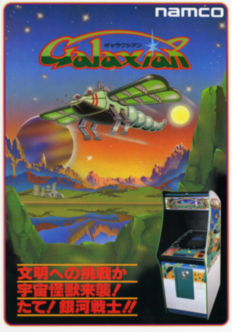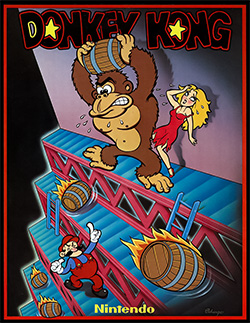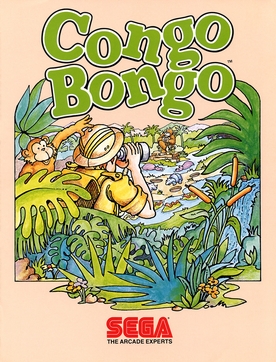
Coleco Industries, Inc. was an American company founded in 1932 by Maurice Greenberg as The Connecticut Leather Company. It was a successful toy company in the 1980s, mass-producing versions of Cabbage Patch Kids dolls and its video game consoles, the Coleco Telstar dedicated consoles and ColecoVision. While the company ceased operations in 1988 as a result of bankruptcy, the Coleco brand was revived in 2005, and remains active to this day.

ColecoVision is a second-generation home video-game console developed by Coleco and launched in North America in August 1982. It was released a year later in Europe by CBS Electronics as the CBS ColecoVision.

Pac-Man, originally called Puck Man in Japan, is a 1980 maze action video game developed and released by Namco for arcades. In North America, the game was released by Midway Manufacturing as part of its licensing agreement with Namco America. The player controls Pac-Man, who must eat all the dots inside an enclosed maze while avoiding four colored ghosts. Eating large flashing dots called "Power Pellets" causes the ghosts to temporarily turn blue, allowing Pac-Man to eat them for bonus points.

Zaxxon is a scrolling shooter developed and released by Sega as an arcade video game in 1982. The player pilots a ship through heavily defended space fortresses. Japanese electronics company Ikegami Tsushinki was also involved in the game's development.

Frogger is a 1981 arcade action game developed by Konami and published by Sega. In North America, it was distributed by Sega/Gremlin. The object of the game is to direct five frogs to their homes by dodging traffic on a busy road, then crossing a river by jumping on floating logs and alligators.

Ms. Pac-Man is a 1982 maze arcade video game developed by General Computer Corporation and published by Midway. It is the first sequel to Pac-Man (1980) and the first entry in the series to not be made by Namco. Controlling the title character, Pac-Man's wife, the player is tasked with eating all of the pellets in an enclosed maze while avoiding four colored ghosts. Eating the larger "power pellets" lets the player eat the ghosts, who turn blue and flee.

Miner 2049er is a platform game developed for Atari 8-bit computers by Bill Hogue and released by his company, Big Five Software, in 1982. The player controls Bounty Bob through multiple levels of a mine, with the goal of traversing all of the platforms while avoiding or defeating enemy mutants. At a time when "climbing games" such as Donkey Kong had four screens, Miner 2049er had ten.
1983 has seen many sequels and prequels in video games, such as Mario Bros. and Pole Position II, along with new titles such as Astron Belt, Champion Baseball, Dragon's Lair, Elevator Action, Spy Hunter and Track & Field. Major events include the video game crash of 1983 in North America, and the third generation of video game consoles beginning with the launch of Nintendo's Family Computer (Famicom) and Sega's SG-1000 in Japan. The year's highest-grossing video game was Namco's arcade game Pole Position, while the year's best-selling home system was Nintendo's Game & Watch for the third time since 1980.

Galaxian is a 1979 fixed shooter arcade video game developed and published by Namco. The player assumes control of the Galaxip starfighter in its mission to protect Earth from waves of aliens. Gameplay involves destroying each formation of aliens, who dive down towards the player in an attempt to hit them.
The golden age of arcade video games was the period of rapid growth, technological development, and cultural influence of arcade video games from the late 1970s to the early 1980s. The release of Space Invaders in 1978 led to a wave of shoot-'em-up games such as Galaxian and the vector graphics-based Asteroids in 1979, made possible by new computing technology that had greater power and lower costs. Arcade video games switched from black-and-white to color, with titles such as Frogger and Centipede taking advantage of the visual opportunities of bright palettes.

Donkey Kong is a 1981 arcade video game developed and published by Nintendo. As Mario, the player runs and jumps on platforms and climbs ladders to ascend a construction site and rescue Pauline from a giant gorilla, the titular Donkey Kong. It is the first game in the Donkey Kong series as well as Mario's first appearance in a video game.

Congo Bongo, also known as Tip Top, is a platform game released as an arcade video game by Sega in 1983. A message in the ROM indicates it was coded at least in part by the company Ikegami Tsushinki. The game is viewed in an isometric perspective, like Sega's earlier Zaxxon (1982), but does not scroll. Numerous home ports followed.
Fueled by the previous year's release of the colorful and appealing Pac-Man, the audience for arcade video games in 1981 became much wider. Pac-Man influenced maze games began appearing in arcades and on home systems. Pac-Man was the highest grossing video game for the second year in a row. Nintendo's Donkey Kong defined the platform game genre, while Konami's Scramble established scrolling shooters. The lesser known Jump Bug combined the two concepts into both the first scrolling platform game and the first platform shooter. Other arcade hits released in 1981 include Defender, Frogger, and the Galaxian sequel Galaga.
1980 saw the release of a number of games with influential concepts, including Pac-Man, Battlezone, Crazy Climber, Mystery House, Missile Command, Phoenix, Rally-X, Space Panic, Stratovox, Zork, Adventure, and Olympic Decathlon. The year's highest-grossing video game was Namco's arcade game Pac-Man, while the best-selling home system was Nintendo's Game & Watch. The Atari VCS also grew in popularity with a port of Space Invaders and support from new third-party developer Activision.

Mr. Do! is a 1982 maze game developed by Universal. It is the first arcade video game to be released as a conversion kit for other arcade machines; Taito published the conversion kit in Japan. The game was inspired by Namco's Dig Dug released earlier in 1982. Mr. Do! was a commercial success in Japan and North America, selling 30,000 arcade units in the US, and it was followed by several arcade sequels.
In video gaming parlance, a conversion is the production of a game on one computer or console that was originally written for another system. Over the years, video game conversion has taken form in a number of different ways, both in their style and the method in which they were converted.

Atari, Inc. was an American video game developer and home computer company founded in 1972 by Nolan Bushnell and Ted Dabney. Atari was a key player in the formation of the video arcade and video game industry.
The 1980s was the second decade in the industry's history. It was a decade of highs and lows for video games. The decade began amidst a boom in the arcade business with giants like Atari still dominating the American market since the late-1970s. Another, the rising influence of the home computer, and a lack of quality in the games themselves led to an implosion of the video game market that nearly destroyed the industry in North America. It took home consoles years to recover from the crash, but Nintendo filled in the void with its Nintendo Entertainment System, reviving interest in consoles. Up until this point, most investors believed video games to be a fad that has since passed. In the remaining years of the decade, Sega ignites a console war with Nintendo, developers that had been affected by the crash experimented with the more advanced graphics of the PC, and Nintendo released the Game Boy, which would become the best-selling handheld gaming device for the next two-decades. Other consoles releases in the decade included the Intellivision, TurboGrafx-16 and Sega Genesis. Notable games of the 1980s included Super Mario Bros, Duck Hunt, Metroid, Elite, SimCity, Galaga,Pitfall!, Frogger, Mike Tyson's Punch-Out!!, Defender, Mega Man 2, The Legend of Zelda, Castlevania, Ghosts 'n Goblins, Super Mario Bros. 2, Bubble Bobble, Double Dragon,Final Fight, Ninja Gaiden,Tetris, Adventure, Joust, Robotron: 2084, Pac-Man, Dig Dug, Arkanoid,Populous, R-Type, Contra, Donkey Kong, Centipede, Super Mario Bros. 3, Prince of Persia, Sid Meier's Pirates!, Where in the World Is Carmen Sandiego?,Gauntlet, Dragon's Lair, Golden Axe, Ms. Pac-Man, Out Run, Dungeon Master,Final Fantasy, Altered Beast, Shinobi, Lode Runner, Battlezone,Dragon Quest, Ultima IV: Quest of the Avatar, and Marble Madness.

An arcade video game is an arcade game where the player's inputs from the game's controllers are processed through electronic or computerized components and displayed to a video device, typically a monitor, all contained within an enclosed arcade cabinet. Arcade video games are often installed alongside other arcade games such as pinball and redemption games at amusement arcades. Up until the late 1990s, arcade video games were the largest and most technologically advanced sector of the video game industry.













